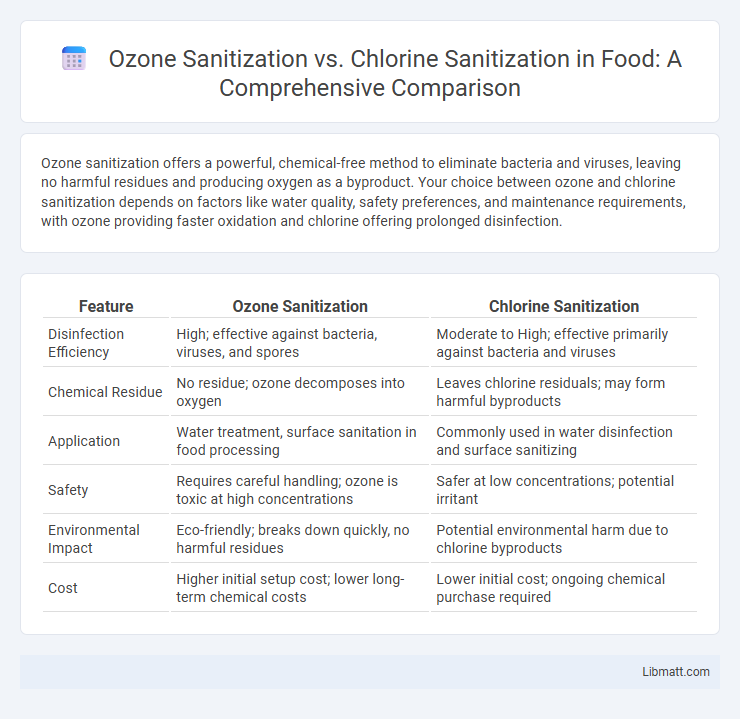Ozone sanitization offers a powerful, chemical-free method to eliminate bacteria and viruses, leaving no harmful residues and producing oxygen as a byproduct. Your choice between ozone and chlorine sanitization depends on factors like water quality, safety preferences, and maintenance requirements, with ozone providing faster oxidation and chlorine offering prolonged disinfection.
Table of Comparison
| Feature | Ozone Sanitization | Chlorine Sanitization |
|---|---|---|
| Disinfection Efficiency | High; effective against bacteria, viruses, and spores | Moderate to High; effective primarily against bacteria and viruses |
| Chemical Residue | No residue; ozone decomposes into oxygen | Leaves chlorine residuals; may form harmful byproducts |
| Application | Water treatment, surface sanitation in food processing | Commonly used in water disinfection and surface sanitizing |
| Safety | Requires careful handling; ozone is toxic at high concentrations | Safer at low concentrations; potential irritant |
| Environmental Impact | Eco-friendly; breaks down quickly, no harmful residues | Potential environmental harm due to chlorine byproducts |
| Cost | Higher initial setup cost; lower long-term chemical costs | Lower initial cost; ongoing chemical purchase required |
Introduction to Water Sanitization Methods
Ozone sanitization uses powerful ozone gas to eliminate bacteria, viruses, and contaminants by oxidizing organic matter, offering a chemical-free alternative with rapid disinfection and minimal residuals. Chlorine sanitization relies on chlorine compounds to kill pathogens effectively and maintain water safety, but it may leave chemical residues and produce disinfection byproducts. Your choice between these methods depends on factors like water quality, regulatory standards, and environmental impact.
Understanding Ozone Sanitization
Ozone sanitization utilizes ozone gas (O3) to effectively destroy bacteria, viruses, and other pathogens through oxidation, offering a powerful alternative to traditional chlorine-based methods. Unlike chlorine, ozone breaks down organic contaminants without leaving harmful chemical residues or producing chlorinated byproducts. This method enhances water quality by providing rapid disinfection, reducing chemical usage, and minimizing environmental impact in applications such as water treatment, swimming pools, and air purification.
How Chlorine Sanitization Works
Chlorine sanitization works by releasing hypochlorous acid when dissolved in water, which penetrates and destroys the cell walls of bacteria, viruses, and other pathogens. This chemical action effectively neutralizes harmful microorganisms, making water safe for consumption and surfaces clean. You benefit from chlorine's rapid disinfection and widespread use in swimming pools, drinking water, and wastewater treatment.
Efficacy: Ozone vs Chlorine in Eliminating Pathogens
Ozone sanitization exhibits superior efficacy in eliminating a broader spectrum of pathogens, including bacteria, viruses, and protozoa, due to its powerful oxidative properties that disrupt microbial cell walls and nucleic acids more effectively than chlorine. Chlorine sanitization, while widely used and cost-effective, can be less efficient against certain chlorine-resistant pathogens such as Cryptosporidium and Giardia, and often requires higher concentrations and longer contact times to achieve similar disinfection levels. Your choice of sanitization method should consider ozone's rapid pathogen inactivation and lower chemical residue compared to chlorine, optimizing safety and water quality.
Safety Considerations for Both Methods
Ozone sanitization offers a safer alternative to chlorine by producing no harmful chemical residues and breaking down quickly into oxygen, reducing the risk of respiratory irritation or chemical burns. Chlorine sanitization, while effective, requires careful monitoring to avoid toxic levels and can cause skin and eye irritation with prolonged exposure. Your choice should weigh ozone's chemical-free safety profile against chlorine's established but more hazardous handling requirements.
Environmental Impact: Ozone and Chlorine Compared
Ozone sanitization produces no harmful chemical residues, breaking down into oxygen, which minimizes environmental pollution and reduces harmful byproducts in water treatment. Chlorine sanitization, while effective, generates chlorinated organic compounds that can persist in ecosystems, potentially harming aquatic life and producing toxic disinfection byproducts. Choosing ozone over chlorine can significantly lower a facility's environmental footprint by avoiding the release of hazardous chemicals into natural water sources.
Cost Analysis: Upfront and Maintenance Expenses
Ozone sanitization systems incur higher upfront costs due to the advanced equipment required for ozone generation, but they typically have lower maintenance expenses since ozone is produced on-site and leaves no chemical residues. Chlorine sanitization involves lower initial investment for simpler dosing equipment but demands ongoing costs for purchasing chlorine chemicals and managing potential corrosion and byproduct disposal. Over time, ozone can offer cost savings in maintenance and chemical procurement despite a higher capital expenditure at installation.
Residual Effects on Water Quality
Ozone sanitization leaves no harmful residuals as it quickly breaks down into oxygen, ensuring water remains free of chemical contaminants after treatment. Chlorine sanitization, however, maintains a residual presence to continuously disinfect but can lead to the formation of disinfection byproducts like chloramines, impacting water taste and odor. The rapid dissipation of ozone makes it ideal for sensitive aquatic environments where maintaining natural water quality is critical.
Practical Applications: Residential and Industrial Use
Ozone sanitization offers powerful disinfection for both residential and industrial use, effectively eliminating bacteria, viruses, and odors in water and air systems without leaving harmful residues. Chlorine sanitization remains widely used in pools, drinking water, and wastewater treatment due to its cost-effectiveness and established regulatory acceptance. Your choice between ozone and chlorine depends on factors like installation complexity, operational costs, and the specific sanitation needs of your environment.
Conclusion: Choosing the Best Sanitization Solution
Ozone sanitization offers powerful, chemical-free water treatment with rapid disinfection and no harmful residues, making it ideal for eco-conscious environments. Chlorine sanitization remains a cost-effective, widely used method with proven efficacy and ease of application, especially suitable for large-scale water systems. Selecting the best sanitization solution depends on factors such as budget, environmental impact, system size, and specific water quality requirements.
Ozone Sanitization vs Chlorine Sanitization Infographic

 libmatt.com
libmatt.com